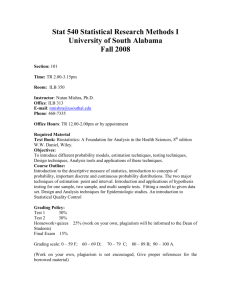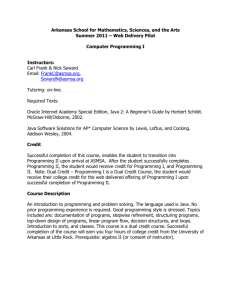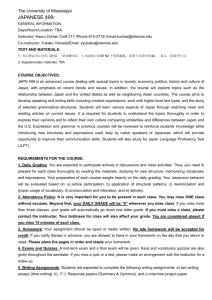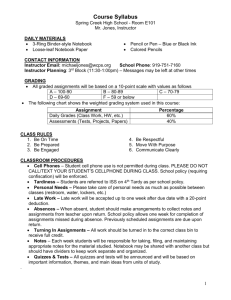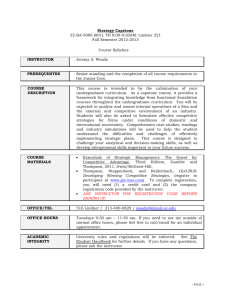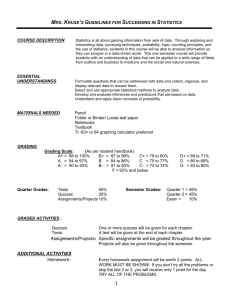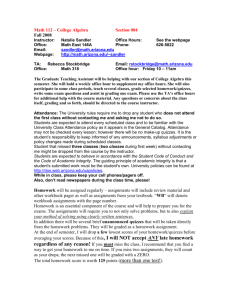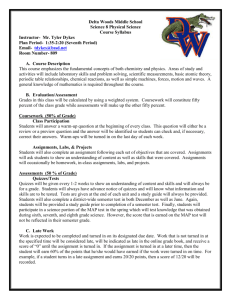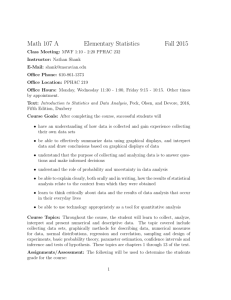Principles of Good Practice in Online Education
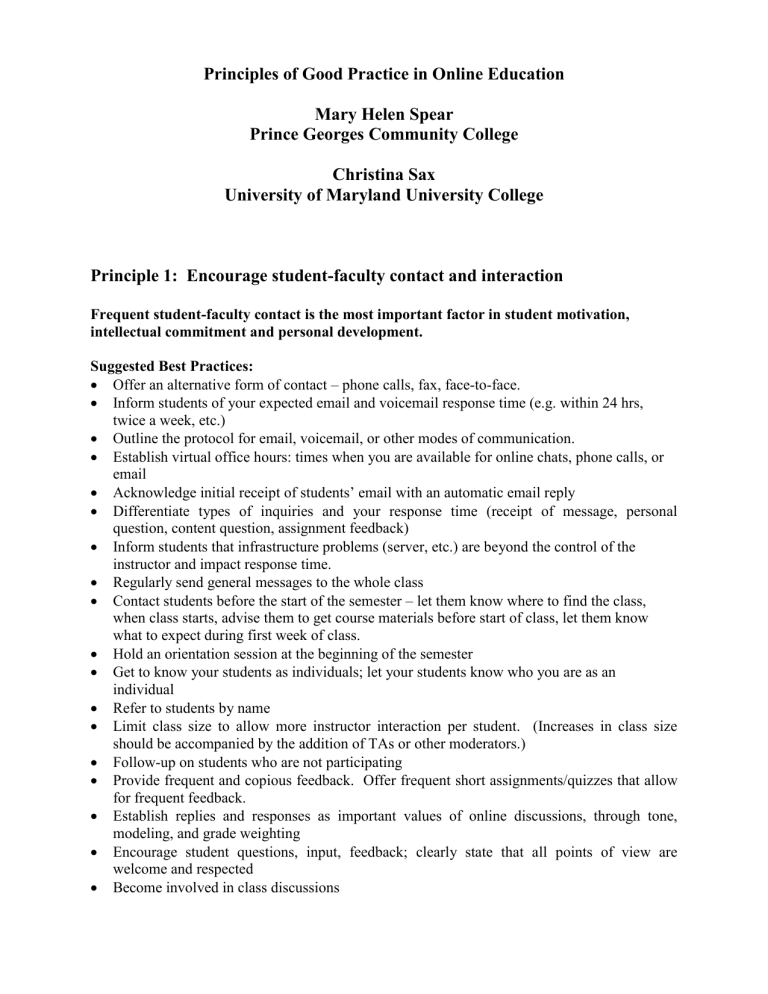
Principles of Good Practice in Online Education
Mary Helen Spear
Prince Georges Community College
Christina Sax
University of Maryland University College
Principle 1: Encourage student-faculty contact and interaction
Frequent student-faculty contact is the most important factor in student motivation, intellectual commitment and personal development.
Suggested Best Practices:
Offer an alternative form of contact – phone calls, fax, face-to-face.
Inform students of your expected email and voicemail response time (e.g. within 24 hrs, twice a week, etc.)
Outline the protocol for email, voicemail, or other modes of communication.
Establish virtual office hours: times when you are available for online chats, phone calls, or email
Acknowledge initial receipt of students’ email with an automatic email reply
Differentiate types of inquiries and your response time (receipt of message, personal question, content question, assignment feedback)
Inform students that infrastructure problems (server, etc.) are beyond the control of the instructor and impact response time.
Regularly send general messages to the whole class
Contact students before the start of the semester – let them know where to find the class, when class starts, advise them to get course materials before start of class, let them know what to expect during first week of class.
Hold an orientation session at the beginning of the semester
Get to know your students as individuals; let your students know who you are as an individual
Refer to students by name
Limit class size to allow more instructor interaction per student. (Increases in class size should be accompanied by the addition of TAs or other moderators.)
Follow-up on students who are not participating
Provide frequent and copious feedback. Offer frequent short assignments/quizzes that allow for frequent feedback.
Establish replies and responses as important values of online discussions, through tone, modeling, and grade weighting
Encourage student questions, input, feedback; clearly state that all points of view are welcome and respected
Become involved in class discussions
Principle 2: Encourage student cooperation
Cooperative learning that is characterized by interaction, personal responsibility, collaborative skills, and group processing enhances learning.
Suggested Best Practices:
Design activities that promote cooperation
Provide an organization of the course and content that encourages cooperation
Use techniques for fostering student cooperation: peer reviews, chats, bulletin boards, discussion forums, group projects, study groups, team learning
Encourage links between students: 1) exchange of student phone numbers and emails, 2) interview and introduce one another
Ask students to complete a personality questionnaire for the formation of compatible and effective learning/study/work groups (http://polaris.umuc.edu/~rouellet/learning/)
Principle 3: Encourage active learning
To maximize learning, students must interact with the material they are learning, write about it, relate it to past experiences, and incorporate what they are learning into the their world view.
Suggested Best Practices:
Ask students to state what they expect to learn in the class
Ask students to provide and critique URLs that enhance learning
Pose discussion questions that foster critical thinking and problem solving
Use open-ended question to encourage extended and wide-ranging dialog
Use quizzes/questions that require students to review the content (self-check or automatically graded online)
Ask students to teach their classmates
Ask students to develop/create: learning products, knowledge artifacts, concept maps
Encourage opinions as well as facts
Follow-up reading assignments with discussions, simulations, or applications to case studies/scenarios
Select real-world, relevant, and practical assignments that allow students to apply and practice the concepts learned
Ask students to critique other students’ work.
Ask student to reflect on their learning – What have you learned (in your own words)? Why is this new knowledge important?
Principle 4: Give prompt feedback
The faculty role is key as it gives the students help in assessing their knowledge and competence.
Suggested Best Practices:
Respond with frequent email: with answers to questions, comments about lesson/unit content, giving directions and information
Return tests, papers, assignments, etc within one week
Hold virtual office hours for students to discuss their graded work
Post grades regularly
Acknowledge all student questions
Use quizzes/questions that require students to review the content (self-check or automatically graded online)
Differentiate types of inquiries and your response time (receipt of message, personal question, content question, assignment feedback)
Principle 5: Emphasize Time on Task
Learning takes place when time is used effectively and actively.
Suggested Best Practices:
Provide an orientation session/course overview which indicates total time students should expect to expend each week, the importance of time on task, and time management skills
Provide learning objectives for each module/lesson/chapter
Indicate suggested time-on-task for each task
Assign something for students to respond to for lesson or class
Use quizzes/questions that require students to review the content (self-check or automatically graded online)
Assign student partner interactions with deadlines
Post notes from each reading assignment and ask each student to respond
Use open-ended question to encourage extended and wide-ranging dialog
Require online discussions
Build in a reward system of points for all student work
Make assignments enjoyable for students to encourage increased time-on-task
Make students aware of time that would have been spent sitting in a face-to-face class and travelling to class for comparison to time expended on online class.
Principle 6: Communicate High Expectations
The self-fulfilling prophecy is a powerful factor. A teacher who holds high expectations for his/her students will have students who perform well.
Suggested Best Practices:
Include course goals, performance objectives, grading and evaluation criteria, grading rubrics, and examples of good student work in the Syllabus
Clearly state your expectations regarding: quality, quantity, depth, breadth, and frequency of discussion participation and interaction; relative emphasis on facts, concepts, critical thinking and analysis, writing, format, and quantitative reasoning; deadlines; etiquette; internet usage; frequency of check-ins
Post outstanding, average, and poor student work at a course Web site or conference area
Set high standards for yourself
Model high standards and quality through example
Convey your enthusiasm and passion for the subject (use emoticons)
Principle 7: Respect Diverse Talents and Ways of Learning
Helping a student to recognize his own learning style can improve a student's learning.
Recognizing the learning styles of others can increase a student's repertoire of learning strategies.
Suggested Best Practices:
Recognize, respect, and reward creativity
Design more than one method of learning for students
Design more than one method of assessment and demonstration of student achievement
Allow students to choose from different possible modes of project presentation, established up front in a learning contract between instructor and student
Understand and allow for different pacing
Encourage student to use the Web and other resources and media to master course content
Ask students to complete a learning style assessment questionnaire
Design course materials to encourage analysis, synthesis, application, and evaluation
Recognize that distance education and online classes are not the preferred or best learning environment for some students
Be sensitive to possible cultural differences
Understand and appreciate the distance learner’s lifestyle, capabilities, and available resources
Principle 8: Let Students Know What to Expect
By letting students know what they can expect from you and in the course many potential problems can be averted ahead of time. Often, these problems are the result of misconceptions that students bring to the online course.
Suggested Best Practices:
Inform students of your expected email and voicemail response time (e.g. within 24 hrs, twice a week, etc.)
Use a calendar to let students know when you won’t be available
Hold an orientation session at the beginning of the semester
Discuss the respective roles of instructor and student in the class - independent, active, student-centered learning with the instructor as mentor/facilitator
Ask students to complete a self-assessment for distance learning skills and characteristics
(“Do you have what it takes to be a successful web student?” at http://www.umuc.edu/prog/ugp/bmgt_news.html)
Indicate the amount of time students should expect to expend each week (90-120 hours total,
6-8 hours/week for a 3 credit 15 week class; and compare to total time expended per week on travel to, attendance in, and work for face-to-face class)
Include course goals, performance objectives, grading and evaluation criteria, grading rubrics, and examples of good student work in the Syllabus
Clearly state your expectations regarding: quality, quantity, depth, breadth, and frequency of discussion participation and interaction; relative emphasis on facts, concepts, critical thinking and analysis, writing, format, and quantitative reasoning; deadlines; etiquette; internet usage; frequency of check-ins
Indicate availability of knowledge, resources, technology, and support
Dispel misconceptions about online classes by stating that classes are: rigorous college-level courses, have real due dates and deadlines, interactive not independent.
Principle 9: Make Effective Use of the Technology
One technology does not fit all. Use a technology that fits the needs of your students, your college, your discipline.
Suggested Best Practices:
Do not choose a technology simply because it is new or flashy
Use technology and resources that are appropriate for your discipline
Use technology and resources that are appropriate for the task
Use consistent design throughout the course
Obtain training in the best and most effective use of each technology employed
Interact with colleagues frequently regarding practices in online teaching and the use of technology in teaching
Be flexible in the use of technology, using a mix of technology as appropriate
Encourage the establishment of a help desk (7 days, 24 hrs) at your school to support all technology
Provide students with examples of good/reputable and bad/questionable internet sites
Provide students with examples of effective and ineffective use and design of various media
(power point, etc.)
Use online tutorials regarding research and writing skills
Use online classroom functions (chat, bulletin board, assignment folders, email, postal mail) appropriate for the task
Incorporate introductory activities as an additional objective reinforce student mastery of basic classroom functions and technologies (email, read messages, write messages, internet searches)

